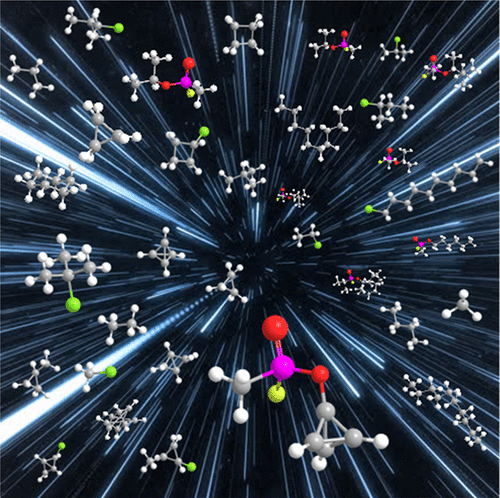当前位置:
X-MOL 学术
›
J. Chem. Educ.
›
论文详情
Our official English website, www.x-mol.net, welcomes your
feedback! (Note: you will need to create a separate account there.)
Nomenclature, Chemical Abstracts Service Numbers, Isomer Enumeration, Ring Strain, and Stereochemistry: What Does Any of This Have to Do with an International Chemical Disarmament and Nonproliferation Treaty?
Journal of Chemical Education ( IF 2.5 ) Pub Date : 2020-07-03 , DOI: 10.1021/acs.jchemed.0c00547 Giovanna Pontes 1 , Julieta Schneider 1 , Peter Brud 1 , Lucas Benderitter 1 , Bernhardt Fourie 2 , Cheng Tang 3 , Christopher M. Timperley 4 , Jonathan E. Forman 5
Journal of Chemical Education ( IF 2.5 ) Pub Date : 2020-07-03 , DOI: 10.1021/acs.jchemed.0c00547 Giovanna Pontes 1 , Julieta Schneider 1 , Peter Brud 1 , Lucas Benderitter 1 , Bernhardt Fourie 2 , Cheng Tang 3 , Christopher M. Timperley 4 , Jonathan E. Forman 5
Affiliation

|
The Chemical Weapons Convention (CWC) is an international disarmament and nonproliferation treaty that mandates a comprehensive ban on chemical weapons. This treaty entered-into-force in 1997 and has a nearly universal membership of world states. The CWC provides definitions for what constitutes a chemical weapon and describes chemicals for which verification measures and regulatory oversight are required. These chemicals, which must be declared to the Organisation for the Prohibition of Chemical Weapons for verification purposes, appear in three Schedules within the CWC. The Schedules list specific chemical substances and families of chemicals defined by molecular structure descriptions that allow a range of specified variable groups. The text of an international treaty provides a basis for laws and regulatory requirements at international and national levels that must be enacted to comply with treaty obligations. These laws and regulations must account for the “chemistry” that is described in the treaty text, which has been negotiated and agreed upon by world governments. In this paper, we look at some of the chemicals described within the CWC and discuss how atoms and molecules, nomenclature, and Chemical Abstracts Service numbers, isomer enumeration, ring strain, and stereochemistry influence the obligations of States to an international treaty. The material draws upon the authors’ experiences from an interactive “Science for Diplomats” initiative that has provided a forum for engaging with chemical disarmament decision-makers to aid in their understanding of fundamental concepts in chemistry that have an impact on treaty implementation. We hope this article will spark interest from chemistry students and educators in the provision of science advice for policymakers and provide policymakers with an appreciation of the complexity and importance of understanding the language of chemistry in support of a world free of chemical weapons.
中文翻译:

术语,化学文摘社服务编号,异构体枚举,环应变和立体化学:这与国际化学裁军和不扩散条约有什么关系?
《化学武器公约》(CWC)是一项国际裁军与不扩散条约,要求全面禁止化学武器。该条约于1997年生效,几乎是世界各州的普遍成员。《化学武器公约》提供了构成化学武器的定义,并描述了需要核查措施和监管的化学物质。必须将这些化学物质宣布为《禁止化学武器组织》以进行核查,这些化学物质出现在《化学武器公约》的三个附表中。附表列出了由分子结构描述定义的特定化学物质和化学家族,这些分子结构描述允许一定范围的指定变量组。国际条约的案文为必须制定以遵守条约义务的国际和国家层面的法律和法规要求提供了基础。这些法律和法规必须考虑条约文本中所描述的“化学”,该文本已由世界各国政府协商并达成协议。在本文中,我们研究了《化学武器公约》中描述的某些化学物质,并讨论了原子和分子,命名法和化学文摘社编号,异构体枚举,环应变和立体化学如何影响国家对国际条约的义务。该材料借鉴了作者从互动式“外交官科学”倡议中获得的经验,该倡议为与化学裁军决策者进行互动提供了一个论坛,以帮助他们理解对条约实施有影响的化学基本概念。我们希望本文能引起化学专业的学生和教育工作者的兴趣,为决策者提供科学建议,并使决策者理解理解化学语言以支持一个没有化学武器的世界的复杂性和重要性。
更新日期:2020-07-14
中文翻译:

术语,化学文摘社服务编号,异构体枚举,环应变和立体化学:这与国际化学裁军和不扩散条约有什么关系?
《化学武器公约》(CWC)是一项国际裁军与不扩散条约,要求全面禁止化学武器。该条约于1997年生效,几乎是世界各州的普遍成员。《化学武器公约》提供了构成化学武器的定义,并描述了需要核查措施和监管的化学物质。必须将这些化学物质宣布为《禁止化学武器组织》以进行核查,这些化学物质出现在《化学武器公约》的三个附表中。附表列出了由分子结构描述定义的特定化学物质和化学家族,这些分子结构描述允许一定范围的指定变量组。国际条约的案文为必须制定以遵守条约义务的国际和国家层面的法律和法规要求提供了基础。这些法律和法规必须考虑条约文本中所描述的“化学”,该文本已由世界各国政府协商并达成协议。在本文中,我们研究了《化学武器公约》中描述的某些化学物质,并讨论了原子和分子,命名法和化学文摘社编号,异构体枚举,环应变和立体化学如何影响国家对国际条约的义务。该材料借鉴了作者从互动式“外交官科学”倡议中获得的经验,该倡议为与化学裁军决策者进行互动提供了一个论坛,以帮助他们理解对条约实施有影响的化学基本概念。我们希望本文能引起化学专业的学生和教育工作者的兴趣,为决策者提供科学建议,并使决策者理解理解化学语言以支持一个没有化学武器的世界的复杂性和重要性。











































 京公网安备 11010802027423号
京公网安备 11010802027423号